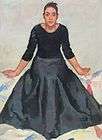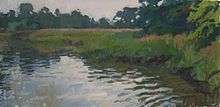Jerry Weiss (artist)
| Jerry Weiss | |
|---|---|
 Weiss (in red) teaching a life class at Lyme Academy College of Fine Arts | |
| Born |
October 21, 1959 New Jersey |
| Education | Art Students League of New York, National Academy of Design |
| Known for | Figurative painting |
Jerry Weiss (born October 21, 1959) is an American figurative, landscape, portrait painter[1][2] and writer. He studied classical drawing, and his career has centered on both the figure (usually from life studies), and landscape (often painted in the outdoors). He says he is "intrigued by the portrait and figure as a most sacred subject."[3]
Weiss is a contributing editor of The Artist's Magazine, for which he writes a "Master Class" feature with an overview of old masters. He is the son of the comic book artist Morris Weiss.
Life and art
Jerry Weiss's parents met at the Art Students League of New York. His mother wanted to be a fashion artist, but dedicated herself to family while continuing to paint. His father is cartoonist Morris Weiss from whom, Weiss says, he inherited an irreverence to life.[4]
Weiss was born in New Jersey but soon after the family moved to North Miami, Florida.[4] He was influenced by the graphic freedom and assured skill of cartoonists, whose work he saw in his father's large collection. Morris asked for his son's advice when buying works by Dean Cornwell (1892–1960)[4] and had once sat for James Montgomery Flagg (1877–1960).[4] As a child, he had over his bed a Saturday Evening Post cover by J. C. Leyendecker (1874–1951) and later a drawing by Norman Rockwell.[4]
However, Weiss was put off narrative work after seeing his father's daily hard-working routine for comics such as Mickey Finn and Joe Palooka.[4] He sought more enjoyment and personal freedom, and decided to learn classical drawing. He was recommended by George Bolge, a museum director, to study with Roberto Martinez, who had been a student of the sculptor, Marino Marini. From Martinez, Weiss learned to draw life-size, a practice he later taught.[4] He studied at the Art Students League of New York, where Ted Seth Jacobs instructed him on light and form. He also studied with Harvey Dinnerstein, whose "emphatic draftsmanship" he admired,[4] at the National Academy of Design in New York City.[5]

He began his career during the 1980s as a figurative painter.[6] Ten years later, he took on landscapes – a genre in which he is self-taught – eventually realizing he could treat them as he did a figure in an interior, in terms of composition, pattern and shape.[4] In 1994 he started teaching at Lyme Academy College of Fine Arts.[5] He held a one-man exhibition at the Boca Raton Museum of Art in 1999. The executive director of the museum, George S. Bolge, wrote of his paintings:
- Jerry Weiss is a product of his age ... Weiss with a great heritage goes to the past for design concepts for form, but looks to the present for his investigation of content.[7]
Weiss said the hardest portraits to work on were impatient sitters with no interest in the art. He explained:
- I enjoy spending three or four days with people who have knowledge in their field, and I would like to think it's vice versa. I find great enjoyment in these situations. Once the time is up, the portrait becomes not just a painting in a collection, but a memory of personal time shared.[1]
He has held solo exhibitions at galleries in New York, Boston, New Jersey and Maine. His work is represented in the New Britain Museum of American Art;[5] the University of North Carolina at Chapel Hill;[5] Pfizer Inc.;[5] the Harvard Club of New York;[5] Brigham and Women's Hospital in Boston; Debevoise and Plimpton, New York. He has taught workshops and lectured in Florida, New York, Washington, Maine, and Colorado. Having long taught painting and drawing at the Lyme Academy College of Fine Arts,[8] Weiss currently instructs at the Art Students League of New York.[9] He is listed in Who's Who in American Art[5] and Who's Who in America. In 2012 he curated an exhibition of large-scale figure works that included paintings by Dinnerstein, Mary Beth McKenzie, Dan Gheno and Tom Loepp.[10]
Weiss is represented by The Cooley Gallery, Old Lyme, Connecticut, and Portraits Inc., New York.[5]
Technique

Weiss uses a wood palette and a small range of colors; typically titanium white, yellow ochre, ultramarine blue and cadmium red light, sometimes with the addition of a deeper red, cadmium yellow light, cerulean and green. He occasionally paints with a knife, but mostly with flat brushes to achieve "a kind of blocky modeling". He uses Claessens oil-primed linen for portraits and panels for landscape work.[4] After forming quick outlines, he works rapidly to block in the light and dark areas of the figure and major compositional elements with turpentine-thinned paint. Following this first stage which takes around half-an-hour, he reworks the areas a dozen times or more, constantly refining and unifying.[4]
Weiss usually works to the sizes of a range of standard frames, which are mostly finished in metal or gold leaf.[11]
Writing
Weiss is a contributing editor of The Artist's Magazine,[12] for which, in July 2008, he began a regular "Master Class" feature of art historical analyses on painting, the history of painting and various works and periods in Western art history.[13] Among his other features have been assessments of contemporary masters, and an essay on his father.[14]
Weiss has also written essays for fine art publications and art auction catalogues.[15][16][17]
Awards and honors
- Fellowship for Painting, New Jersey State Council on the Arts
- Best in Show, Hortt Annual, Museum of Art, Fort Lauderdale, Florida
- Isaac Maynard Price, National Academy of Design, New York, 159th Annual Exhibition
- Phillip Isenburg Prize, Salmagundi Club Annual Show, New York
Public collections
- Boca Raton Museum of Art
- New Britain Museum of American Art
- University of North Carolina at Chapel Hill
Gallery
-

Expectation, Wendy and Adrian, 2008, oil on canvas, 36" x 48".
-

Adriane, c. 2000, oil on canvas, 48" x 36".
-

Portrait of Daniel Edwards, who is sculpting a head of Jerry Weiss; c.2000, oil on canvas, 60 x 38".
-

Standing Nude, 2002, oil on canvas, 48" by 24".
-

Spring, Mosquito Head, 2009, oil on canvas, 30" x 40".
-

Spring Trees, 2005, oil on canvas, 48" x 36".
-

Cobalt Autumn, 2007, oil on canvas, 30" x 36".
-

Evening, Duck River, 2004, oil on canvas, 24" x 48".
References
- 1 2 Hagen, Debbie. "Profiling portraits: the most custom of all custom art—portraits, can present a variety of challenges to artists and art dealers", Art Business News. Retrieved September 7, 2009.
- ↑ Keating, Christopher. Sullivan Portrait Unveiled, Hartford Courant. March 1, 2008
- ↑ "http://www.jerrynweiss.com/about_frame.htm]". jerrynweiss.com. Retrieved May 22, 2016
- 1 2 3 4 5 6 7 8 9 10 11 Bloomfield, Maureen. "Light that stops time", The Artist's Magazine, p.35-41, June 2008.
- 1 2 3 4 5 6 7 8 "An entirely new benefit auction experience", Florence Griswold Museum. Retrieved September 13, 2009. (Archived by WebCite.)
- ↑ Wolff, Theodore F. "Portrait of the artist as a young master", Christian Science Monitor. Retrieved September 7, 2009.
- ↑ Bolge, George S. "Jerry Weiss: Landscapes", Boca Raton Museum of Art. Retrieved September 6, 2009
- ↑ Figure painting Workshop Retrieved October 9, 2010
- ↑ Art Students League Retrieved August 26, 2012
- ↑ Big as Life Retrieved August 26, 2012
- ↑ Parks, John A. "Professional Artists Tell All", American Artist, June 22, 2006. Retrieved September 13, 2009.
- ↑ "Faculty: Jerry Weiss", Silvermine Guild Arts Center. Retrieved February 26, 2010.
- ↑ Listing of articles, Villanova University Library
- ↑ Morris Weiss: A Life Spent Drawing Cartoons Retrieved August 26, 2012
- ↑ Catalogue on Lockwood de Forest.
- ↑ Lockwood de Forest essay
- ↑ Essay on Jasper Francis Cropsey.
- ↑ "Jerry Weiss: Resume, The Brigham Galleries. Retrieved September 13, 2009.
Further reading
- "When artists judge other artists", The Christian Science Monitor, March 5, 1984.
- "Hortt exhibit is fine finale", The Miami Herald, May 17, 1985.
- "Personal expression prevails at 27th Hortt Competition", News/Sun Sentinel (FT. Lauderdale, Fl.), May 19, 1985.
- "Portrait of the artist as a young master", The Christian Science Monitor, July 25, 1985.
- "Weiss Thrice Equals a Winning Art Show", Gold Coast Weekly Magazine, April 19–26, 1991.
- "Making Models into Art: How six Portrait Painters...", The Artist's Magazine, December 1993.
- "Some whimsy at juried show in New Britain", The Hartford Courant, August 27, 1995.
- "Portrait, Landscape painter brings work to Old Lyme", The Day (New London, Ct), October 9, 1997.
- "Paintings of Jerry Weiss Featured in Solo Exhibition at Lyme Academy of Fine Arts", Antiques and The Arts Weekly, October 24, 1997.
- "Revealing Images", The Day, New London, February 22, 2002.
- "Lyme Academy Instructor Jerry Weiss to Show Paintings at The Cooley Gallery", Antiques and The Arts Weekly, August 30, 2002.
- "Across the Bridge", New York Times, Connecticut section, September 29, 2002.
- "Jerry Weiss: Observe, Think, and Practice", American Artist Workshop for Oil and Acrylic Painters, pages 86–99, Winter 2005.
- Art in Embassies Program, United States Embassy Kigali, U.S. Department of State, 2006, pages 10–12.
- "Beyond Expectation: Nonarchival Drawing Surfaces", American Artist Drawing Magazine, Spring 2006, p. 28-29.
External links
- Jerry Weiss official website
- Portraits
- A Lasting Impression, Hartford Courant, March 4, 2008
- Art in Embassies, U.S. Department of State
- Artist to unveil paintings at the Main Street Gallery in Chester Jan. 15, Middletown Press, January 14, 2010
- Hamden Art League kicks off season with portrait and landscape artist Jerry Weiss, Post-Chronicle, August 25, 2010
- Making a statement, The Day, illustrated. January 19, 2010
- Four artists arrive, but from different directions, Westerly Sun, illustrated. December 18, 2009